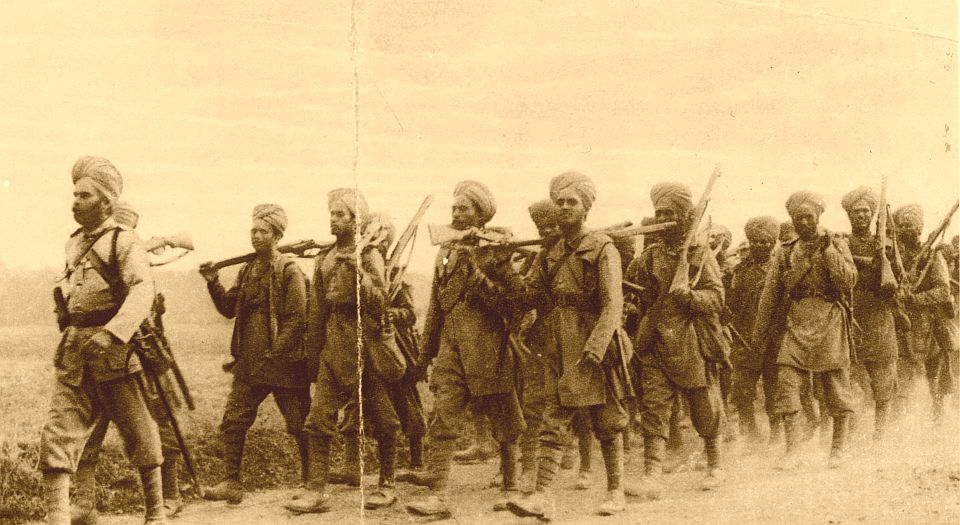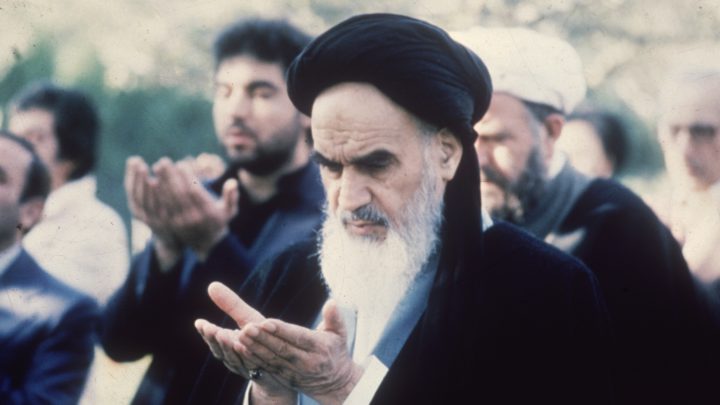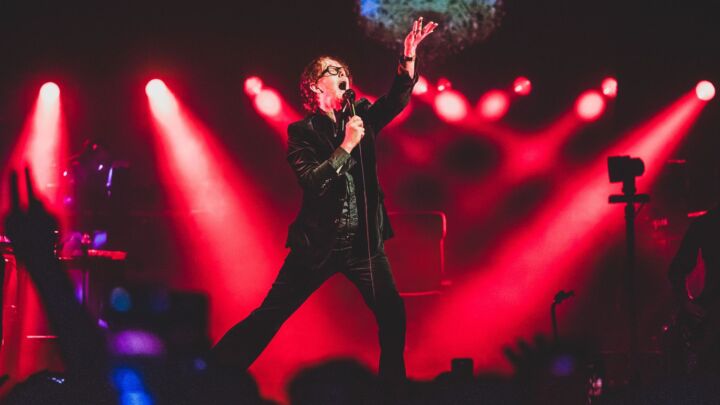
Long-read
India’s untold story
The Indian Army's contribution to the Allied war effort has been downplayed for far too long.
Want to read spiked ad-free? Become a spiked supporter.
In 2016, as George Morton-Jack notes in The Indian Empire at War, the city of Brighton & Hove unveiled a blue plaque dedicated to Mir Dast, a Muslim and a member of the Afridi tribe of Pashtuns based in Tirah, west of Peshawar. King-Emperor George V had, in August 1915, bestowed Dast with a Victoria Cross at the Royal Pavilion Indian military hospital in Brighton. Dast had been wounded leading a platoon in a counterattack, in the face of German gas, at the Second Battle of Ypres in April 1915. All of which Brighton & Hove wanted to commemorate.
In 2018, in the run-up to Armistice Day, the Birmingham suburb of Smethwick has gone one better. In a first for Britain, it has unveiled a 10-foot high bronze of a Sikh fighter. As with Brighton & Hove, the aim is to commemorate the contribution made by Indians to British efforts in the First World War. Indeed, in that cause even the Daily Mail has joined in, doing a direct lift of a Guardian review of Morton-Jack’s book, inevitably titled ‘Indians in the trenches: voices of forgotten army are finally to be heard’.
This is how memorials are now made to the Indian Army in the Great War — to its one million active soldiers and to its less conspicuous, non-combatant forces of support, who numbered a further half million. Yes, British sorrow about the Fallen of the First World War has long been personalised, sentimentalised and apolitical. But with the Indian Army, however, today’s rather breathless tributes are framed in a specially uncritical and also specially multicultural way, as suits the times. The right-on message: Indians, many of them Muslims, were put upon by racist British officers, yet gave much for our side in the fight with Germany – so it’s about time we remember them, too.
Interpretations of the Indian Army’s record were not always like that. Indeed, early on in his narrative, Morton-Jack, a young, Oxford-trained British historian, repudiates the ‘forgotten heroes’ thesis about the Indian Army. The author has on his side a vivid prose style, wonderful photographs and maps, a mastery of archival material and a very commendable ferreting out of 1000 transcribed pages of interviews with Indian veterans, which he tracked down to the house of an aged American academic in Albany, upstate New York. Yet Morton-Jack also excels by noting that, from 1917 onward, top British generals and politicians, going against the cavalier judgements of Herbert Asquith, David Lloyd George, Rudyard Kipling, Arthur Conan Doyle and John Buchan, fully recognised how Indian Army reinforcements on the Western front had done nothing less than prevent the collapse of the Allies in the First World War (1).
In fact, after being commander-in-chief of the British Indian Army from 1942 to 1945, Field Marshall Claude Auchinleck later reminisced that English politicians ‘couldn’t have come through both wars if they hadn’t had the Indian Army… I think they never really understood it’ (2). Still, after the bloody Partition of India in 1947, the subcontinent’s massive shoulder to the wheel of the Allied cause in two worldwide conflagrations was, like Britain and the post-war Labour government’s responsibility for Partition, conveniently disappeared from the British public’s view (3).
Now it is back on the streets of Britain, courtesy of political-class identity politics.
Typically enough, today’s media circus around Indians in the First World War patronises them in the grand old manner. Commentary highlights their pluck with the bayonet much more than their relatively high levels of discipline during wartime, their military innovations in that period, or the global disposition of Indian forces, which stretched from Africa, through the Middle East, up to Belgium and out to East Asia.
Morton-Jack deals with these issues well and in a balanced manner. His wider achievement is not just to tell what he reasonably calls the ‘untold story’ of the Indians in the carnage of 1914-18, but to show how, at various points, the Indian Army was absolutely critical to the British prosecution of that carnage. Indeed, the Indian Army also turned out to be vital to Britain, particularly against the Japanese, in the Second World War – just as vital to Britain as Indian supplies of food, steel, cement, timber and textiles were in that latter conflict.
Morton-Jack brilliantly and vividly shows how, in the Great War, Indians didn’t simply add a significant boost to Allied numbers against a much better equipped German Army, one that mustered no fewer than 3.8 million men. In Belgium at the First Battle of Ypres, October-November 1914, Indians played a key if indirect role: they were rushed in to hold 12 miles – about a third – of the line held by the British Expeditionary Force (BEF). Itself holding half of the whole Allied line at First Ypres, the BEF was by 1 November down to 30 per cent of its opening strength, and was completely exhausted. The Indian Corps, General Haig acknowledged in private, ‘saved the situation’ by staunching a critical gap. With that, Morton-Jack writes, Indian Expeditionary Force A probably rescued the whole Allied cause in the west in 1914.
At about 75,000, Indian casualties were relatively low in the Great War. One of the reasons may have been that Indian troops were much more battle-hardened than their critics imagined – not just in combat, but in digging trenches and being on the receiving end of artillery. Morton-Jack outlines how Britain more or less successfully trained the Indian Army in repression. Ever since the First Anglo-Afghan War of 1839-42, it knew cold conditions and mountain warfare, going on to deepen its expertise around the independent Pukhtun tribal areas of Tirah, Waziristan and Mohmand that lay squeezed between Afghanistan and British India’s North West Frontier Province. In Beijing, Shanghai and Eastern China, more than 30,000 Indians burned villages and executed civilians while suppressing the Boxer Rising (1900-02). They meted out similar treatment to Tibet (1903-4), and to Iranian villages on the shores of the Persian Gulf (1911). In the infamous massacre at the Jallianwala Bagh, a square in Amritsar, Punjab, on 13 April 1919, Indian soldiers showed that they knew how to do the bidding of their British officers. Thereafter, with the British Empire’s conquests in Africa and Asia bloating its pre-war size by 27 per cent, Britain still had to rely upon Indian veterans for their armed service overseas: the British Army in Europe was, Morton-Jack writes, ‘largely unavailable, preoccupied with bringing troops home from France and fighting the Irish War of Independence’.
As the British Liberal economist JA Hobson remarked right back in 1902, the use of ‘armies composed of subject peoples’ was a feature of imperialism as deep-seated as its parasitic reliance on financialisation. Hobson went on:
‘One of the strangest symptoms of the blindness of imperialism is the reckless indifference with which Great Britain, France and other imperial nations are embarking on this perilous dependence. Great Britain has gone farthest. Most of the fighting by which we have won our Indian Empire has been done by natives; in India, as more recently in Egypt, great standing armies are placed under British commanders; almost all the fighting associated with our African dominions, except in the southern part, has been done for us by natives.’ (4)
Rather than present the Indians at war simply as loyal victims of racism, Morton-Jack is sensitive to the tense, conflicted nature of Indian servicemen’s undoubted commitment to the Allied cause
Therefore, and with some notable exceptions, the Indian Army was broadly a formidable fighting force by 1914. In that year alone, a modest number of Sikhs witnessed, with other Empire troops, the surrender of German infantry and marines in a Japanese Army siege of the German seaport of Qingdao, north-east China. Similarly, Indians occupied the city of Basra in what is now Iraq, and fought Germans in Tanga, East Africa (very badly). From the outset the massive role played by the Indian Army in France, Belgium, the Middle East and, to a lesser degree, in East Asia and East Africa, confirmed the global character of the First World War. Importantly, too, Indians joined with Commonwealth forces in the abortive attack on Gallipoli in 1915. Though secondary to the Western front, the Allies’ struggle against Turkey and the Ottoman empire involved the greatest part of the Indian Army: no fewer than 430,000 soldiers and 330,000 non-combatants.
Around Turkey and the Middle East, Whitehall worried about Muslim Indian Army troops turning against their British masters, angry at being forced to attack fellow Muslims. In a distant yet still significant precedent for today’s British establishment back-peddling in the face of Islam, the War Office made strenuous attempts, on top of its usual subtle, multi-layered, divide-and-rule forms of discrimination and concession, to forestall Indian and above all Muslim mutiny. In the event, despite Germany’s best efforts, Indian desertion and outright revolt turned out pretty small.
Rather than present the Indians at war simply as loyal victims of racism, or – just as simply – as useless cowards, Morton-Jack is sensitive to the tense, conflicted nature of Indian servicemen’s undoubted commitment to the Allied cause against Germany. The mostly Punjabi force was loyal primarily because of above-average pay and the promise, given long service, that some would get a pension and a 50-acre plot of canal-irrigated land, guaranteed free of debt collectors. Even that, though, did not prevent resentment, especially among the independent Pukhtun tribesmen of the north west; and by the late 1930s, Indian veterans of the First World War, having spent years waiting for Britain to offer the democratic dividend they thought they deserved, belatedly stood ready to throw their hand in with Indian nationalism and its resistance to London rule.
The career of Mir Dast, so trumpeted in Brighton, in fact reflects the taut, fraught nature of commitment to the Empire. Mir Dast not only received a VC; like his still more renegade brother Mir Mast, he deserted. Then, after the war was over, he became, until his death in 1945, a strong advocate of getting jobs with the British, not resisting them.
In war, little is simple. Morton-Jack’s account can be faulted on a number of counts; his opening characterisation of the Great War as a conflict simply between ‘militarism versus liberalism, authoritarianism versus democracy’ does not sit too well with his criticism of the British Raj. Much has changed in the past 100 years, even if United Nations troops are active around the world, and, in the Sahel, East Africa, local soldiers today do the EU’s bidding. Nevertheless, The Indian Empire at War is a brilliant work of scholarship, and, into the bargain, a very exciting read. Recommended.
James Woudhuysen is visiting professor of forecasting and innovation at London South Bank University. He is also editor of Big Potatoes: the London Manifesto for Innovation. Read his blog here.
The Indian Empire at War: from jihad to victory, the untold story of the Indian Army in the First World War, by George Morton-Jack, is published by Little Brown. (Buy this book from Amazon(UK).)
(1) Though necessarily biased through years of leading Indian troops, General Sir James Willcocks’ With the Indians in France, 1920, was a very sympathetic account of the Indian Army: the pay of ‘Indian officers especially’, Willcocks acknowledged, ‘was almost an insult to a class so loyal and devoted’. It is true that the British military theorist Basil Liddell Hart, in his 1930 history The real war, 1914-1918, failed to mention India (see Hart, History of the First World War, Papermac, 1997). However, as late as 1934 CRMF Cruttwell, an infantry officer in France who became a War Office intelligence officer and, between 1930 and 1939, principal of Hertford College, Oxford, had to make a few mild nods to the Indian contribution in East Africa, France, Iraq, Egypt and Palestine. See his A history of the Great War 1914-1918, Paladin Granada, 1982, pp 73, 99, 210, 339, 617, 619.
(2) Oral Archives No. 2/6, British Library, St Pancras, London, quoted in the Open University, ‘Making Britain: Discover how South Asians shaped the nation, 1870-1950 – Second World War (1939-1945)’
(3) ‘Disappeared’ it certainly was. On the British right, Alan Clark’s famous polemic against the British High Command, The Donkeys (1961), Pimlico, 1991, p25 touched on the Indians only to take a pop at the moaning distaste General Sir Douglas Haig felt toward the behaviour and – naturally – the ‘very close’ atmosphere generated by ‘British and Native clerks’ working together at the Indian Corps HQ at Hinges chateau in France. Around the US Democratic Party, Barbara Tuchman’s seminal The Guns of August — August 1914 (1962) made no mention of the Indian Army, even though that was the very month it drew up battle plans for defending the Anglo-Persian Oil Company – now BP – from seizure by the Turks. On the British left, AJP Taylor could only murmur that Indian troops were ‘used in France, where the climate hampered them’: see his The First World War: An Illustrated History (1963), Penguin, 1966, p45. Then, in the 1990s and 2000s, after America’s victory in the Cold War, tub-thumping US historians, as well as Britain’s own John Keegan, dismissed Indian prowess.
(4) Hobson, Imperialism, A Study (1902), quoted in V I Lenin, Imperialism, the Highest Stage of Capitalism: A Popular Outline (1916)
Who funds spiked? You do
We are funded by you. And in this era of cancel culture and advertiser boycotts, we rely on your donations more than ever. Seventy per cent of our revenue comes from our readers’ donations – the vast majority giving just £5 per month. If you make a regular donation – of £5 a month or £50 a year – you can become a and enjoy:
–Ad-free reading
–Exclusive events
–Access to our comments section
It’s the best way to keep spiked going – and growing. Thank you!






Comments
Want to join the conversation?
Only spiked supporters and patrons, who donate regularly to us, can comment on our articles.